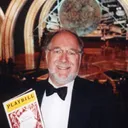Stay in the Loop
BSR publishes on a weekly schedule, with an email newsletter every Wednesday and Thursday morning. There’s no paywall, and subscribing is always free.
Sidewalks of New York, salsa-style
"In the Heights' on tour

In the Heights is an innovative show based in the traditions of musical theater— sort of case of pouring new Hispanic wine into old Jewish, Italian or Irish bottles. Its theme— poor immigrants try to improve their lives in New York City— is similar in essence to Michael Tilson Thomas's Thomashefsky Project, a tribute to his grandparents, Boris and Bessie Thomashefsky, who were superstars in Yiddish-American theater from the 1880s to World War II. That Yiddish theater nourished the mainstream American show business that followed.
Then it was Jews from Eastern Europe. Now it's Hispanics from Central America and the Caribbean. Many Yiddish productions had sets just like In the Heights with crowded streets, storefronts and pushcarts. The struggle is the same, and both incarnations have optimistic, uplifting conclusions.
In the Heights bears an even more specific similarity to A Catered Affair, a masterpiece of mid-20th century naturalism. In Paddy Chayefsky's teleplay, later made into a movie and a musical, an Irish-American cab driver dreams of buying his own taxi and providing a better life for his family. In the Heights gives prominence to Rosario's Limousine Service, owned by a man who wants his daughter to get a college degree.
Windows always open
Lin-Manuel Miranda, the show's creator and narrator (on Broadway), is a 31-year-old who grew up in Manhattan's Washington Heights and conceived In the Heights when he was a sophomore at Wesleyan University. His show chronicles three days in the life of a vibrant and tight-knit community in the shadow of the George Washington Bridge. It's a place where, as Miranda portrays it, the coffee from the corner bodega is light and sweet, the windows are always open and the breeze carries the rhythms of three generations of music.
Yiddish-American musicals integrated Eastern European klezmer and cantorial modes. Miranda similarly incorporated varied musical forms from Hispanic experiences. When the elderly lady who raised him, Abuela (grandmother) Claudia, sings about her life, "Calor! Calor! Calor!" Miranda reflects Latina history by quoting the melody of the 1944s rumba, "Amor, Amor, Amor."
Residents of Washington Heights come from diverse cultures, so Miranda used disparate rhythms for his songs. Some of the residents sing and dance salsa, some merengue, some reggae, some bachata; and the narrator, Usnavi, uses rap.
The missing narrator
The show's ten major roles are sung and acted especially well for a touring production— on the same high level as the Broadway cast. Joseph Morales is charismatic as Usnavi, but I miss the unique experience of seeing Miranda portray the part himself. Nicholas Christopher was particularly effective as Benny, a black limousine dispatcher who falls in love with his boss's daughter and finds himself rejected because he is a different ethnicity.
The excellent set by Anna Louizos is almost identical to what I saw during the show's Broadway run. Andy Blankenbuehler supplied the kinetic choreography.
And if New York immigrant show biz success stories are your cup of tea, here's another piece of good news: Tilson Thomas's Thomashevsky Project arrives in Philadelphia in February.
Then it was Jews from Eastern Europe. Now it's Hispanics from Central America and the Caribbean. Many Yiddish productions had sets just like In the Heights with crowded streets, storefronts and pushcarts. The struggle is the same, and both incarnations have optimistic, uplifting conclusions.
In the Heights bears an even more specific similarity to A Catered Affair, a masterpiece of mid-20th century naturalism. In Paddy Chayefsky's teleplay, later made into a movie and a musical, an Irish-American cab driver dreams of buying his own taxi and providing a better life for his family. In the Heights gives prominence to Rosario's Limousine Service, owned by a man who wants his daughter to get a college degree.
Windows always open
Lin-Manuel Miranda, the show's creator and narrator (on Broadway), is a 31-year-old who grew up in Manhattan's Washington Heights and conceived In the Heights when he was a sophomore at Wesleyan University. His show chronicles three days in the life of a vibrant and tight-knit community in the shadow of the George Washington Bridge. It's a place where, as Miranda portrays it, the coffee from the corner bodega is light and sweet, the windows are always open and the breeze carries the rhythms of three generations of music.
Yiddish-American musicals integrated Eastern European klezmer and cantorial modes. Miranda similarly incorporated varied musical forms from Hispanic experiences. When the elderly lady who raised him, Abuela (grandmother) Claudia, sings about her life, "Calor! Calor! Calor!" Miranda reflects Latina history by quoting the melody of the 1944s rumba, "Amor, Amor, Amor."
Residents of Washington Heights come from diverse cultures, so Miranda used disparate rhythms for his songs. Some of the residents sing and dance salsa, some merengue, some reggae, some bachata; and the narrator, Usnavi, uses rap.
The missing narrator
The show's ten major roles are sung and acted especially well for a touring production— on the same high level as the Broadway cast. Joseph Morales is charismatic as Usnavi, but I miss the unique experience of seeing Miranda portray the part himself. Nicholas Christopher was particularly effective as Benny, a black limousine dispatcher who falls in love with his boss's daughter and finds himself rejected because he is a different ethnicity.
The excellent set by Anna Louizos is almost identical to what I saw during the show's Broadway run. Andy Blankenbuehler supplied the kinetic choreography.
And if New York immigrant show biz success stories are your cup of tea, here's another piece of good news: Tilson Thomas's Thomashevsky Project arrives in Philadelphia in February.
What, When, Where
In the Heights. Music and lyrics by Lin-Manuel Miranda; book by Quiara Alegria Hudes. Through January 17-23, 2011 at the Academy of Music, Broad and Locust Sts. (215) 731-3333 or www.kimmelcenter.org.
Sign up for our newsletter
All of the week's new articles, all in one place. Sign up for the free weekly BSR newsletters, and don't miss a conversation.

 Steve Cohen
Steve Cohen